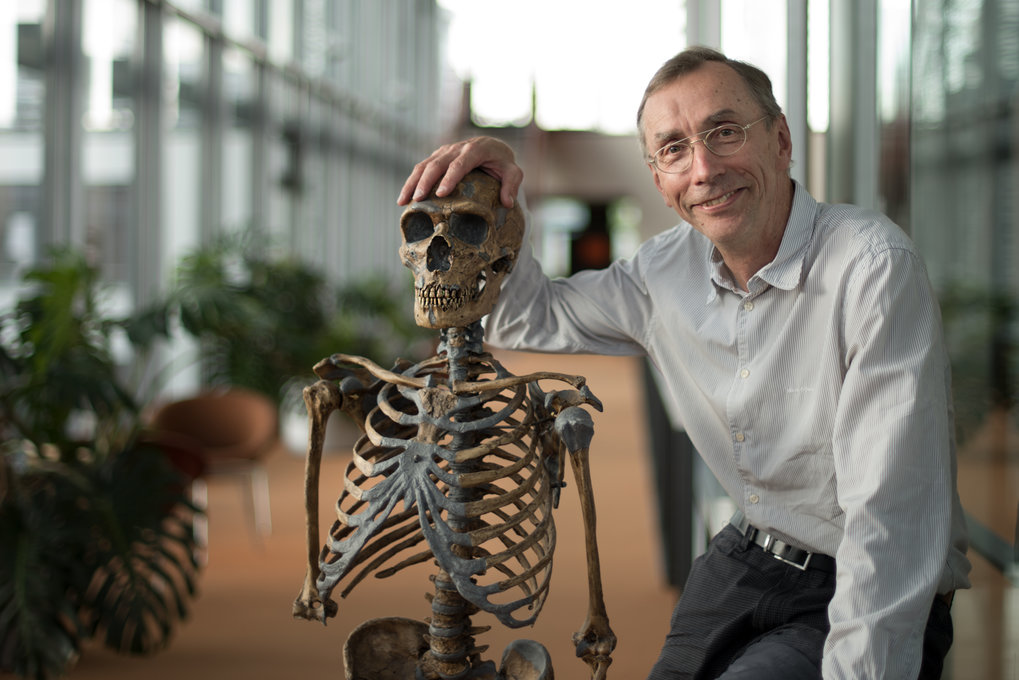Geneticist Svante Pääbo honoured for his work into human origins
Svante Pääbo, Director at the Max Planck Institute for Evolutionary Anthropology in Leipzig, is the founder of palaeogenetics, a research discipline concerned with the analysis of genetic samples from fossils and prehistoric finds. Which of the genetic changes that occurred in the course of evolutionary history make up modern man is what Pääbo studies by comparing the DNA sequences of modern-day humans, Neanderthals and other human ancestors. His groundbreaking research has now earned him Japan Prize, which is endowed with mit 50 million Yen (approx. 490,000 euros).

Svante Pääbo, Director at the Max Planck Institute for Evolutionary Anthropology in Leipzig, is the founder of palaeogenetics, a research discipline concerned with the analysis of genetic samples from fossils and prehistoric finds. Which of the genetic changes that occurred in the course of evolutionary history make up modern man is what Pääbo studies by comparing the DNA sequences of modern-day humans, Neanderthals and other human ancestors. His groundbreaking research has now earned him Japan Prize, which is endowed with mit 50 million Yen (approx. 490,000 euros).
Born in Stockholm, Sweden in 1955, Svante Pääbo studied Egyptology, Russian and history of science at the University of Uppsala from 1975 and medicine from 1977, before earning his doctorate in cell biology in 1986. He continued his research at the University of Zurich’s Institute of Molecular Biology II, at the Imperial Cancer Research Fund in London and in the Biochemistry Department at the University of California in Berkeley. Pääbo came to Germany in 1990, where he was initially Professor of General Biology and Zoology at LMU Munich. Since 1997 he has headed the Department of Evolutionary Genetics at the Max Planck Institute for Evolutionary Anthropology in Leipzig.
The Neanderthal in us
Pääbo’s major scientific achievements include the determination of the first DNA sequences from a Neanderthal (1997): by comparing the DNA of Neanderthals and modern humans, he was able to demonstrate that Neanderthals were a different branch rather than a missing link in human evolution.
Other milestones in Svante Pääbo’s career are his work on the FOXP2 gene (2002), which is associated with language and speech, the complete decoding of the mitochondrial DNA of a Neanderthal (2008) and sequencing the genome of a Neanderthal (2010). Early analyses revealed that there had been interbreeding between Neanderthals and early modern man. One to four percent of the DNA in the genome of non-Africans alive today is Neanderthal in origin.
Tracking the mysterious Denisovan hominids
Another sensation followed in December 2010, when Pääbo’s team sequenced the nuclear genome of a finger bone that was over 30,000 years old and had been found in Siberia’s Denisova cave, discovering, in the process, a new species of prehistoric human. Denisovans shared a common ancestry with the Neanderthal but went on to take a different evolutionary path. Further analyses (2011) showed that Denisovans handed down DNA to populations currently living in New Guinea, as well as to Australian aborigines and Philippine populations and was spread over a wide ecological and geographical area extending from Siberia to tropical South-East Asia.
Using a new method developed in Pääbo’s department which splits the DNA double helix into its two individual strings and makes both strings accessible for DNA sequencing, the scientists were able to read each base in the Denisovan’s genome some 30 times (2012) and as many as 50 times in the Neanderthal’s (2013). The genome they thereby generated is of a similar quality to that of humans alive today.
Also in 2013, Pääbo and colleagues deciphered the mitochondrial genome of a 400,000-year-old hominid from Spain. A scientific sensation, because until recently, such ancient DNA could only be obtained from fossils from permafrost regions. In a follow-up study from 2016, Pääbo’s team sequenced cell nucleus DNA from fossils from the same cave and was able to prove the relationship of these hominids to Neanderthals
Pääbo’s team sequenced the genome of the oldest modern human being to date, a 45,000-year-old man from Siberia, and discovered relatively long segments of Neanderthal DNA in it, showing that the ancestors of this Siberian had mixed with Neanderthals about 5,000 to 15,000 years before his birth (2014). Recent DNA analyses of a 40,000-year-old jawbone from Romania showed that some of the first modern humans who came to Europe mixed with the Neanderthals living there (2015).
Prize-winning research
Pääbo’s groundbreaking research has been honoured with numerous national and international awards. Among the accolades he has received are the Gottfried Wilhelm Leibniz Prize of the German Research Foundation (1992), the Louis Jeantet Prize for Medicine and the Virchow Medal (2005), the order Pour le mérite (2008), the H.M. The King’s Medal by the King of Sweden (2012) and the Gruber Prize for Genetics (2013).
In 2015 Svante Pääbo was awarded the Breakthrough Prize in Life Science, and in 2016 the Keio Medical Science Prize and the Körber Prize for European Science in 2018.
The Japan Prize will now be awarded to Svante Pääbo on 15 April 2020 in Tokyo. It is awarded by the Science and Technology Foundation of Japan (JSTF) to scientists from around the world whose ground-breaking achievements contribute to the progress of science and technology, as well as to the promotion of peace and prosperity for humanity. It is often referred to as the Japanese Nobel Prize: 88 prize winners from 13 countries have received it since it was awarded for the first time in 1985 – including many later Nobel Prize Laureates.
BA/SJ








